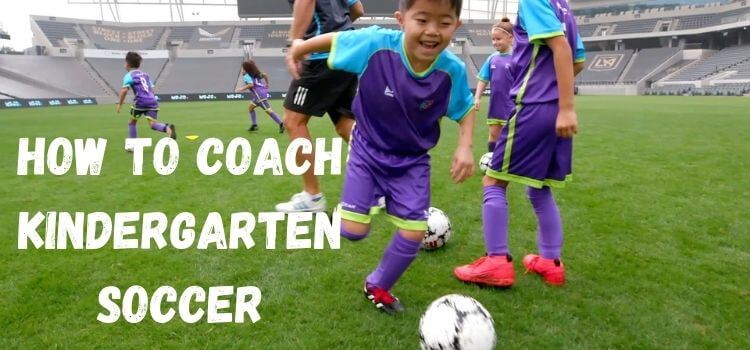As an Amazon Associate, I earn from qualifying purchases
Starting as a kindergarten soccer coach can be a fun and rewarding experience. Coaching young children helps them develop physical skills and instils values such as teamwork, discipline, and sportsmanship. Early soccer coaching sets the stage for a lifelong love of the sport and promotes healthy habits from a young age.

Getting Started
Understanding the Basics
Before diving into coaching, you must familiarize yourself with the basic rules of soccer. Understanding the game will help you teach the kids effectively and answer their questions confidently.
Setting Realistic Goals
At this age, the primary goal is to have fun. Focus on teaching fundamental skills and ensuring the kids enjoy their time on the field. Setting small, achievable goals helps keep the sessions fun and engaging.
Equipment Essentials
Soccer Balls and Goals
Invest in age-appropriate soccer balls and portable goals. Kindergarten kids need more petite, lighter balls that are easier to control and kick. Portable goals can be set up in any open space, making practice more accessible.
Safety Gear
Safety is paramount. Ensure every child has shin guards, and consider using soft headgear for additional protection. Teaching kids to play safely and responsibly can prevent injuries.
Comfortable Clothing
Encourage kids to wear comfortable, weather-appropriate clothing. Soccer uniforms or simple sportswear work best. For better grip and safety, ensure everyone has proper footwear, ideally soccer cleats.
Creating a Positive Environment
Encouraging Fun and Enjoyment
The most crucial aspect of coaching kindergarten soccer is ensuring the kids have fun. Create a joyful and stress-free environment where children look forward to playing soccer.
Building Team Spirit
Promote teamwork by organizing activities that require collaboration. Encourage kids to cheer for each other and celebrate everyone’s efforts.
Basic Skills to Teach
Dribbling
Introduce dribbling through simple games and exercises. Use cones to create obstacles for kids to manoeuvre around, helping them develop control and coordination.
Passing
Teach the basics of passing by pairing up the kids and having them pass the ball back and forth. Emphasize the importance of accuracy and teamwork.
Shooting
Organize shooting drills using small goals. Encourage kids to aim and shoot while moving, which helps them understand the game’s dynamics.
Basic Defense
Introduce defensive skills by teaching kids to stay between the ball and their goal. Simple drills that focus on blocking and intercepting can be very effective.
Planning Practice Sessions
Structuring Practice Time
Practice sessions should be brief and diverse to maintain the kids’ interest. A typical session might include a warm-up, skill drills, games, and a cool-down period.
Warm-Up Activities
Start with light activities like jogging or playing tag to get the kids moving and ready for practice. Warm-ups reduce the risk of injury and prepare the kids for more intensive activities.
Skill Drills
Incorporate a variety of skill drills that focus on dribbling, passing, and shooting. To maintain enthusiasm, keep the drills fun and interactive.
Fun Drills and Games
Dribbling Games
Create fun dribbling games like “Red Light, Green Light,” in which kids dribble on “green” and stop on “red.” These games improve control and responsiveness.
Passing Challenges
Organize passing challenges where kids pass the ball through small gates made of cones. This helps improve their accuracy and teamwork.
Mini Matches
End sessions with mini-matches to give the kids a feel for actual gameplay. Keep teams small to ensure everyone gets involved and has a chance to touch the ball.
Motivational Techniques
Positive Reinforcement
Use positive reinforcement to build confidence. Praise efforts and improvements, no matter how small, to keep the kids motivated.
Setting Small Achievable Goals
Set small, achievable goals for each session. Celebrate when these goals are met to create a sense of accomplishment.
Celebrating Successes
Celebrate successes, whether it’s a well-executed pass or a goal scored. This keeps the kids excited and eager to learn more.
Dealing with Challenges
Managing Short Attention Spans
Kindergarteners have short attention spans, so keep activities brief and varied and change up drills frequently to keep the kids engaged.
Handling Disagreements
Teach kids to resolve conflicts peacefully. To foster a cooperative atmosphere, encourage them to communicate their emotions and listen to one another.
Keeping Everyone Involved
Ensure every child gets equal playing time and opportunities to participate in drills and games. A sense of belonging is promoted through inclusiveness, and participation is encouraged.
Parental Involvement
Communicating with Parents
Keep parents informed about practice schedules, goals, and their child’s progress. Regular communication builds a supportive community around the team.
Encouraging Supportive Behavior
Encourage parents to be supportive spectators. Positive cheering and constructive Feedback from parents can significantly boost the kids’ confidence.
Safety and First Aid
Basic Safety Rules
Teach basic safety rules, such as not pushing or tripping other players. Emphasizing safety helps prevent accidents and ensures a pleasant experience for everyone.
Handling Injuries
Ensure you have a well-filled first aid kit to address minor injuries. Know basic first aid procedures and have emergency contact information readily available.
Promoting Good Sportsmanship
Teaching Respect for Opponents
Instil the value of respecting opponents, regardless of the game’s outcome. Teach kids to shake hands and congratulate each other after games.
Handling Wins and Losses
Help kids understand that winning isn’t everything. Stress the value of working hard and taking lessons from successes and setbacks.
Progress Tracking
Monitoring Skill Development
Track each child’s skill development. Regularly assess their progress and adjust practice sessions to address improvement areas.
Providing Feedback
Give constructive Feedback that focuses on what the kids are doing well and areas where they can improve. Positive Feedback encourages continued effort and growth.
Building Long-Term Interest
Keeping Kids Engaged
Vary the activities and introduce new games regularly to keep kids engaged. Keeping things fresh and exciting helps maintain their interest in soccer.
Promoting a Lifelong Love of Soccer
Encourage kids to watch soccer games and follow their favourite teams. This can inspire them to continue playing and enjoying soccer outside practice sessions.
Conclusion
The kindergarten soccer coach creates a fun, positive, and educational environment. If you emphasize core skills, promote collaboration, and ensure their safety, young children can develop a lifelong love of soccer. The key goal is to help the kids enjoy themselves while playing the game and to pick up helpful life skills.
FAQs
Start by understanding the basics of soccer and setting realistic goals for the kids. Make an effort to create a lively and upbeat atmosphere.
It would help if you had age-appropriate soccer balls, portable goals, shin guards, and comfortable clothing for the kids.
Keep activities short and varied. Use fun games and drills to maintain their interest and enthusiasm.
Concentrate on fundamental abilities like passing, dribbling, shooting, and primary defence.
Teach respect for opponents, emphasize effort over winning, and model good sportsmanship behaviour yourself.
Read Our More Articles
- Why Soccer Matters Book: A Journey Through the World of Soccer
- How to Play World Cup Soccer Drill: A Comprehensive Tutorial
- How to Coach Soccer to 5 Year Olds: Tips and Strategies
As an Amazon Associate, I earn from qualifying purchases


